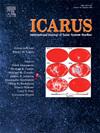Implications of a highly convective lunar magma ocean: Insights from phase equilibria modeling
IF 3
2区 物理与天体物理
Q2 ASTRONOMY & ASTROPHYSICS
引用次数: 0
Abstract
The Moon's internal structure was largely defined within the first 200 million years following the initial Moon-forming impact. During this period, the lunar magma ocean (LMO) lost most of its heat through early vigorous convection, crystallizing and forming an initial cumulate stratigraphy through, potentially, robust equilibrium crystallization followed by fractional crystallization once the LMO became sufficiently viscous. This rheological transition is estimated to have occurred at 50 % to 60 % LMO solidification, and although the petrological effects of the regime switch have been frequently investigated at the lower value, such effects at the upper limit have not been formally examined until now. Given this scenario, we present two new internally consistent, high-resolution models that simulate the solidification of a deep LMO of Earth-like bulk silicate composition at both rheological transition values, focusing on the petrological characteristics of the evolving mantle and crust. The results suggest that increasing the volume of early suspended solids from the oft-examined 50 % to 60 % may lead to non-trivial differences. The appearance of minor mantle garnet without the need to invoke a refractory-element enriched bulk silicate Moon composition, a bulk mantle relatively richer in orthopyroxene than olivine, a lower density upper mantle, and a thinner crust are shown to change systematically between the two models, favoring prolonged early crystal suspension. In addition, we show that late-stage, silica-enriched melts may not have sufficient density to permit plagioclase to continue building a floatation crust and that plagioclase likely sinks or stagnates. As the ability of a lunar magma ocean to suspend crystals is directly tied to the Moon's early thermal state, the degree of early LMO convection – and the immediate Solar System environment that drives it – require as much consideration in LMO models as more well-investigated parameters such as bulk silicate Moon composition and initial magma ocean depth.
高对流月球岩浆海洋的含义:来自相平衡模型的见解
月球的内部结构在最初的月球形成撞击后的最初2亿年内基本确定。在此期间,月球岩浆海洋(LMO)通过早期强烈的对流失去了大部分热量,结晶并形成了最初的累积地层,可能通过强大的平衡结晶,然后在LMO变得足够粘稠时进行分馏结晶。据估计,这种流变转变发生在LMO凝固的50%到60%之间,尽管人们经常在较低的值上研究这种状态切换的岩石学影响,但直到现在,这种影响还没有在上限上进行正式研究。鉴于这种情况,我们提出了两个新的内部一致的高分辨率模型,模拟了在两个流变过渡值下类似地球的大块硅酸盐组成的深部LMO的凝固,重点关注演化中的地幔和地壳的岩石学特征。结果表明,将早期悬浮固体的体积从通常检查的50%增加到60%可能会导致显著的差异。少量地幔石榴石的出现,而不需要使用富含耐火元素的硅酸盐组成,大块地幔中正辉石含量相对高于橄榄石,较低密度的上地幔和较薄的地壳在两种模式之间系统地发生变化,有利于延长早期晶体悬浮。此外,我们表明,晚期富含硅的熔体可能没有足够的密度使斜长石继续形成浮动地壳,而斜长石可能下沉或停滞。由于月球岩浆海洋悬浮晶体的能力与月球早期的热状态直接相关,早期LMO对流的程度——以及驱动它的直接太阳系环境——在LMO模型中需要考虑的因素与更充分研究的参数(如体积硅酸盐月球成分和初始岩浆海洋深度)一样多。
本文章由计算机程序翻译,如有差异,请以英文原文为准。
求助全文
约1分钟内获得全文
求助全文
来源期刊

Icarus
地学天文-天文与天体物理
CiteScore
6.30
自引率
18.80%
发文量
356
审稿时长
2-4 weeks
期刊介绍:
Icarus is devoted to the publication of original contributions in the field of Solar System studies. Manuscripts reporting the results of new research - observational, experimental, or theoretical - concerning the astronomy, geology, meteorology, physics, chemistry, biology, and other scientific aspects of our Solar System or extrasolar systems are welcome. The journal generally does not publish papers devoted exclusively to the Sun, the Earth, celestial mechanics, meteoritics, or astrophysics. Icarus does not publish papers that provide "improved" versions of Bode''s law, or other numerical relations, without a sound physical basis. Icarus does not publish meeting announcements or general notices. Reviews, historical papers, and manuscripts describing spacecraft instrumentation may be considered, but only with prior approval of the editor. An entire issue of the journal is occasionally devoted to a single subject, usually arising from a conference on the same topic. The language of publication is English. American or British usage is accepted, but not a mixture of these.
 求助内容:
求助内容: 应助结果提醒方式:
应助结果提醒方式:


